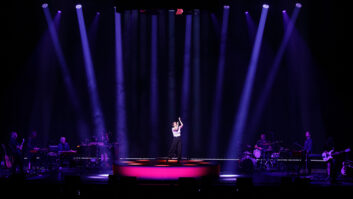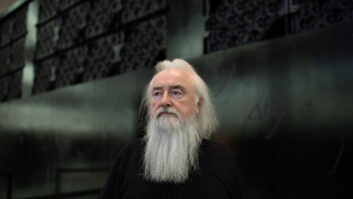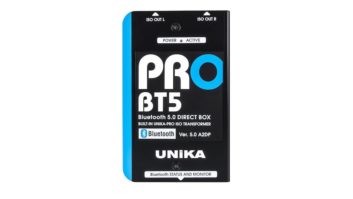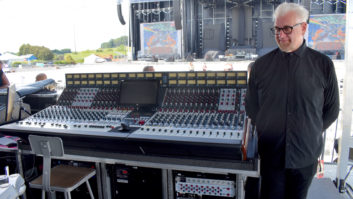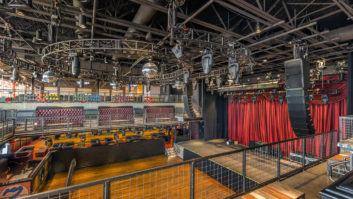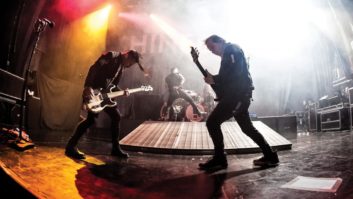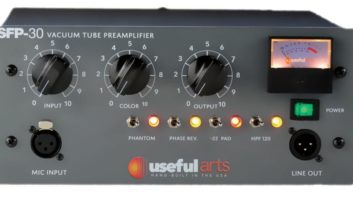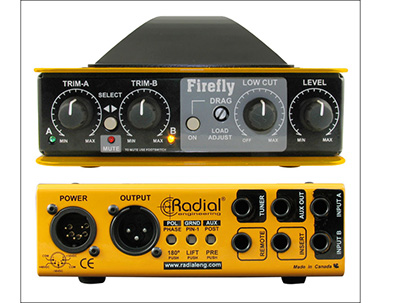
A DI is a simple interface that takes a high-impedance, unbalanced source and makes it compatible with balanced preamps and eventually your DAW. But that’s not all Radial Engineering and A-Designs had in mind when they created these new products that enhance the lowly DI with a gang of great features.
Radial Engineering Firefly Tube Direct Box
The Firefly is a dual-input direct box that uses a single 12AX7 running Class-A. It comes painted “taxicab” yellow in a rugged, all-steel enclosure measuring 5.75×1.75×8.25 inches (WxHxD) with a carrying handle.
Firefly’s utility begins with the protruding frame of the cabinet’s cover that protects the front panel’s controls and switches from accidental access or damage. Configuration switches and trim pots that are used less-frequently are recessed on the unit’s rear, side and front panels.
The Firefly’s A and B inputs have separate level controls and allow for two instruments to be plugged in at the same time. You can preset and balance the volume/record level of both a high-output bass guitar with active pickups/electronics on the A input and the low output of an acoustic upright bass with a piezoelectric pickup system on input B. The Select button silently switches between A and B while the Level control sets the unit’s final output level.
The front panel also has a 25 to 500Hz variable low-cut filter and the Drag push button switch. Drag is a way to load passive pickups for the same feel and sound as if they were driving the input impedance of a guitar or bass amp. Firefly’s nominal input impedance is 4 meg-ohms, but with Drag on the front panel’s recessed screwdriver control varies it from 22 to 500k ohms.
Flush-mounted rear panel ¼-inch jacks include A and B instrument inputs; an “always on” buffered Tuner output; the Aux/Thru Output jack for connection to a stage/studio amplifier; and a TRS jack for connecting Radial’s JR-2 footswitch for A or B switching and output muting. There is also a TRS jack for a buffered send/return insert path, but no onboard bypass switch. The insert point is after the tube stage but before the Level control.
The rear panel finishes with a balanced microphone level XLR output from an Eclipse ET-MS10 transformer and a five-pin XLR power connector to accept the OEM line lump power supply’s ±16-volts and the tube’s 48-volt plate supply.
The recessed configuration switches on Firefly require (preferable) an insulated tool to toggle them. There are switches for ground lift, polarity and, on the side of the unit, a switch for separate transformer isolation of the Aux/Thru path or not.
Finally, an important recessed switch changes the ¼-inch Aux/Thru signal chain completely. When Pre is selected, the buffered feed from your instrument is passed on to your stage/studio amp—a direct box thru. When Post is selected, the final sound of the Firefly includes the tube stage HPF, and insert loop effect as the main XLR output is “mirrored” on the Aux/Thru jack—tube preamp mode.
To avoid a ground loop, I plugged both the amp and Firefly into the same AC wall socket. On powering up, the unit mutes for about 45 seconds while the tube stabilizes. I set the Aux/Thru switch to Pre and switched Drag off. The buffered signal of my stock Fender Strat went to my Fender Blues Junior out in the studio and the Firefly’s XLR output was recorded using my Sunset Sound S1P mic preamps. The sound was clean, clear and with no hum or noise—exactly as my Strat sounds. I found the buffered output sent to the amp using a 25-foot cord to have the same sparkle and life as when using a short cord straight out of the guitar.
The fun started when I set the Aux/Thru path to Post. The entire sound of Firefly is available for both the amp and the XLR connector at the same time. I found this especially good for direct guitar and bass recordings. It was easy to add some “hair” to overly clean bass sounds; and for guitar, the Firefly offered a new shade of coloration as a tube preamp in front of the guitar amp itself.
In Post mode, all Firefly settings including the Level control affect both the amp’s volume and the record level. By cranking up the gain on an input and throttling back the Level control, I could hear the strong saturated sound of the 12AX7 coming into play.
I experimented with the Drag control. Drag does not affect instruments with active electronics, but it does affect the way instruments with passive pickups feel, play and sound. For a direct guitar overdub I started with Drag at the extreme, all the way counter-clockwise at 22k ohms. This produced a very thick, sluggish-responding “dead” and rolled-off sound with no sustain at all! While my guitar player perfected the part for the song, I slowly turned the Drag’s screwdriver adjustment clockwise to partially unload the pickups and restored just the right amount of brightness. Even though Drag is a fiddly screwdriver control, I found both it and the HPF to be useful musical controls in the studio.
Firefly is a great utility piece of studio kit for musicians, studios and FOH engineers to have on hand. It is rugged and fully adaptable to any situation in a studio session or onstage. Recommended!
Product Summary
COMPANY: Radial Engineering
PRODUCT: Firefly Tube Direct Box
PRICE: $599 MSRP
PROS: A worthwhile, flexible piece of musical equipment for studio and stage.
CONS: Some of the controls and switches are not easily accessible.
TRY THIS
The Tuner output of Firefly is always on, so use it to drive an effects pedal or a secondary guitar amp without affecting Firefly’s operation.

A-Designs KGB Instrument Preamplifiers
More than just direct boxes, A-Designs’ KGB-II and KGB-Itf are instrument preamplifiers that supply +4dB balanced line-level outputs into 600-ohms, meaning the KGB (Keyboard, Guitar, Bass) will directly drive the line level inputs of DAW interfaces, line processors and console line inputs with no need of a mic preamp.
The KGB-II is a dual-mono (stereo) unit, while the KGB-Itf is a single-channel version with a three-band active tone stack. Tone control is by way of a Baxandall high/low shelving EQ with corner frequencies at 5 kHz and 180 Hz, respectively. Midrange frequencies are handled by a peaking EQ section with a broad Q centered at 1.8 kHz. Each section is capable of up to 12 dB of cut/boost.
Both models use the same circuit topology that includes large CineMag CMOQ-25 output transformers. Both units have 22-meg-ohm input impedances and work with high-impedance sources, such as guitars and bass guitars, as well as with lower-impedance, higher-output electronic keyboards.
To accommodate any instrument, there are front panel High/Low Gain range switches for selecting either 34 dB or 26 dB of gain. There are Switchcraft ¼-inch Input and Thru jacks, and on the rear panels are XLR output connector(s) and toggle switches for phase flip, ground lift (XLR Pin 1) and power on/off. The KGB preamplifiers are each powered by external wall-wart 20-VAC power modules (supplied). A modified bi-polar voltage-doubler circuit is used for generating the fully regulated ±24-volt rails.
The KGB models each use two discrete op amp modules designed by Carl Johnson. The KGB-II has one for each channel’s line driver and the KGB-Itf uses one for the EQ and the other for the line driver. The modules plug into the main circuit board with spare modules costing $75.
Operation is simple and immediate for either unit. The High/Low Gain toggle switch sets the operating range depending on what source you plug in, and a single aluminum knob sets the final output level.
I first tried the KGB-Itf for recording a Suhr Classic J4 bass guitar. I pushed low frequencies using the low-shelf EQ and took the Suhr to another level with near synth-like subsonics—especially noticeable on slides and percussive “pops.” The center position of the three tone controls is flat, but I wish these pots had center detents.
The KGB-Itf got a great sound from a Suhr Guthrie Govan Signature guitar. As with the bass guitar, I found the sound to be clear and clean and I liked not having to use a console channel strip. I directly connected the KGB to the studio’s Pro Tools HDX interface input.
I then tested the KGB-II as a stereo preamp to record a Korg Triton keyboard. The Triton’s Combi patches put out hot levels, so I set the High/Low gain switch to low. Even with the Level knob on the KGB II fully CCW, I had plenty of level and ended up reducing the Triton’s onboard fader. The sound was clean, clear and dynamic—percussion sounds were bright and not compressed.
Staying with the KGB-II, I then did bass guitar overdubs with my guitar player on a stock Fender Jazz bass with passive pickups. I used the High Gain setting with the Level control at about 1 o’clock. I connected the output directly to a dbx 160A limiter/compressor whose output went into the studio’s Pro Tools interface. This produced a consistent bass sound with percussive attacks well heard, good sustain and solid low frequencies.
Both the KGB II and the KGB-Itf are solid, core investments for any studio, live sound engineer or musician who wants great sound simply. Especially good for console-less project studios, I can recommend them both.
Product Summary
COMPANY: A-Designs Audio, Inc
PRODUCT: KGB-II and KGB-Itf
Instrument Preamplifiers
PRICE: $754 MAP (each)
PROS: A big and warm line-level sound
CONS: A bit big and heavy, KGB-Itf tone controls need detents.
TRY THIS
I hooked up the KGB-II so that the left channel’s Thru signal went into an overdrive pedal. That pedal’s output went to the right channel’s input and its Thru out to the guitar amp. Now I had line-level outputs to record both the guitar’s original clean signal as well as the overdrive pedal’s output signal. You could also connect the guitarist’s entire pedal board instead of just the overdrive pedal. In this way, the guitar player maintains his live amp sound, as well.
Barry Rudolph is an L.A.-based engineer and educator.
